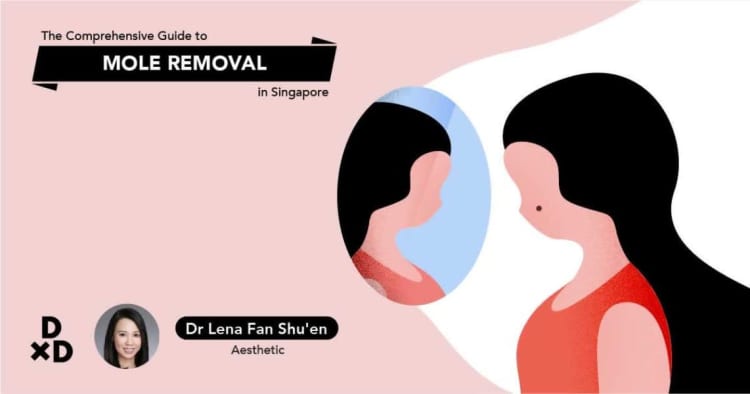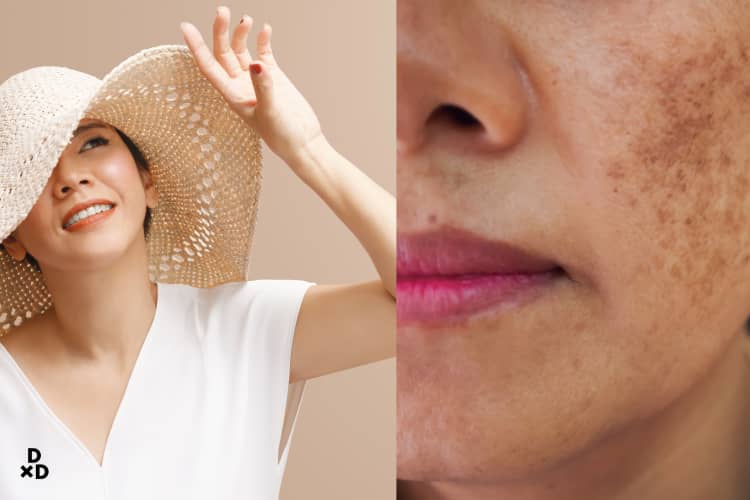Moles are kind of like our old friends. After all, they tend to stick around longer than some people in our lives.
Ranging in size, shape, and colour, most moles seem to be pretty harmless. Some find them a nuisance because they appear at undesirable spots, while others consider their moles to be a special thing that makes them unique.
But what if that mole that you've dismissed is potentially a sign of skin cancer?
With over 18 years of medical experience, Dr Stephanie Ho is a skin specialist that has dedicated a large portion of her focus to moles and skin cancer.
Here's what she has to say about the questions that she always gets asked.
What on earth are moles anyway and where do they come from?

In most cases, moles appear due to our genetic predisposition. Most people develop small brown moles that are harmless. They may be flat, dome-shaped, or bumpy looking. Typically, these moles will appear throughout your childhood.
However, some new moles may appear in adulthood or after pregnancy. Additionally, new moles can be triggered by sun exposure. Most of you would have already known that part, huh?
Keep an eye out for growing moles, they could lead to melanoma
Pay special attention to growing or new moles, because they can change. Melanoma (a dangerous type of skin cancer) might arise from an existing mole that once seemed insignificant.
If you notice a changing mole, you should always see a dermatologist. He/she can assess your mole to find out if the mole is developing into something more serious.
While it is normal for some moles to change in their appearance in a harmless manner, it is still safer to leave such an assessment to a doctor.
Too many moles may also be a red flag for melanoma
If you have more than 50 moles on your body, watch out! You may have a higher risk of developing melanoma.
If you have a family history of melanoma, you should also be more vigilant and undertake annual skin checks.
Use the ABCDE of abnormal moles
Wondering how to self-examine for any mole abnormalities? If your extended family has a history of skin cancer, in between annual skin checks, use the ABCDE (asymmetry, border, colour, diameter, evolution) of abnormal moles to look out for any suspicious signs.

Feeling paranoid about your mole? Let science do its thing
As a trained dermatologist who has worked in the UK as well as in Asian countries, Dr Stephanie has performed plenty of skin checks on different skin types.
She usually scans for unusual pigment networks, different colours, shapes, and patterns, or non-healing ulcerated or bleeding lesions.
If a mole is deemed suspicious, a simple and quick biopsy can be performed to send a sample to the lab for formal testing.
Ditch the mole removal creams for effective laser surgery!
Sure, mole removal creams can work (to some degree), but their effectiveness might vary depending on the ingredients present in each product.
Plus, it’s difficult to establish just how effective the different creams on the shelf can be.
Dr Stephanie is of the opinion that the safest and most effective way to remove moles would be either surgical or by using a laser.
Surgical mole removal is when the mole is removed by cutting it out under local anaesthetic. Don't worry, it sounds a lot scarier than it actually is!
Still feeling a little squeamish? Here’s how mole surgery works

Dr Stephanie’s preferred method of removal involves a quick numbing injection, after which the mole is removed surgically. A few stitches are then applied to close the wound.
This is a simple procedure that typically takes 5-10 minutes for most small moles.
The advantage of using this method is that moles are completely removed from the deep layers of the skin and it is extremely rare that those moles return.
She admitted that scarring will most likely be obvious at first, but most patients barely notice it after 6-12 months.
Small flat moles? Consider laser removal
Laser mole removal is most useful for small flat moles. A numbing cream is first applied onto the area, then your doctor will use a pigment laser to “burn off” the pigmentation from the mole. This procedure can be done in less than five minutes!
Patients are left with a small wound that will scab up over one week and then fall off, leaving a small brown area.
No, pimples don't turn into moles

If you're worried that pimple breakouts which form brown patches could turn into moles, this what Dr Stephanie has to say:
"In Asian skin, all pink pimples will heal leaving a brown mark known as post inflammatory hyperpigmentation. This is due to the higher melanin content in our skin being disturbed during the inflammatory process."
The brown patches that are formed from breakouts usually fade in 2-3 months or even quicker if you apply medical grade lightening creams or a light laser to make the healing process faster.
Just remember to stay out of the sun to help things along.
Moles can be a potential sign of something more serious. It’s important that you pay close attention to any inconsistencies be diligent in order to help make sure you remain healthy, happy, and risk-free.
Ever wanted to ask a health question to a specific renowned specialist in Singapore? Human Sessions are when these expert doctors answer all your questions, for free!
You can Ask A Doctor right away, or view the complete list of Human Sessions here.










